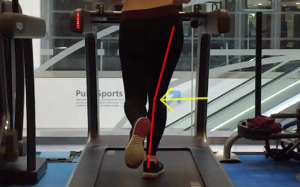I hope you’ve been enjoying the first two parts of our series on understanding and treating runner’s knee. In this section of our series, I’ll be discussing gait re-training. Read on to learn how changes in running form can be used to help runners who suffer with patellofemoral pain.
- Part 1: Load Management for Runner’s Knee
- Part 2: Best Exercises for Runner’s Knee
Gait Re-Training in Patellofemoral Pain Rehab
Let’s talk about gait re-training. Put simply, it’s the process of making targeted changes to your running form to overcome injury.
Gait Re-training: Who is it best for?
Research tells us that females are likely to respond to gait re-training than males. But guys, don’t worry, that’s likely because runner’s knee is more common among women. Clinically, I see lots of males who respond well to gait re-training.
Male or female, if you have a poor running style, you are also more likely to benefit from gait re-training. By poor running style, what we mean is a running style that means that you may look similar to the images and video below:
Trendelenburg Gait (aka Hip Drop)

How can we apply gait re-training?
Working with simple, achievable cues will help you improve your running form . As a start, working with a digital metronome will help you elevate your running cadence, also known as step rate.
It is easy to calculate your cadence for a given pace: Simply count the number of steps that you take when running for 60 seconds. Alternatively, if you run with any wearable technology such as a Garmin watch, it will probably record your cadence.
For some context, the most common step rate that I see in the clinic is 160. There is some evidence that if we increase this by a given percentage (the typical choice being 5-7.5%), that we may achieve some positive changes to your running technique.
Based on this, if I see a runner who has a step rate of less than 172 at an easy conversational pace, I usually look to increase their cadence while maintaining a constant speed on the treadmill, or running at a consistent pace outdoors.
There is no magic number for everyone, so you’ll have to calculate your own and make incremental adjustments.
Runner’s Knee Rehab Resources
FREE DOWNLOAD [PDF]
Pay attention to your foot strike
Biomechanically speaking if you switch from heel striking to run with a forefoot strike pattern, it will generally reduce the impact on your knee.
However, be aware: It is impossible to remove net impact from the body, changing your foot strike simply moves that impact around. You’ll go from loading one joint to another. A foot strike cue is probably the biggest example of where one technique change will benefit body part A (the knee), but upset body part B (the ankle/calf complex). Particularly if you’re suffering from Patellofemoral Pain, this kind of trade off can be very much worth while.
I would caution all runners from changing your foot strike drastically without paying attention to the resulting impact on the rest of your body.
The cues described above are certainly not your only options. When working with a runner, James and I will often cue changes in trunk position, abdominal activity, foot strike/position, contact times and swing path, to name but a few…
It is unlikely that one magical cue will work well for all runners, so be patient and seek the advice of a qualified medical professional with a specialist interest in running form if you are not finding relief.
Remember to take it slowly and consider using our return to running program to give you some structure. It is essential to remember that few treatments work well in isolation, do not forget about the role of exercise!
Further Reading on Running Gait Re-training and Running Form
If any clinicians are reading this, I would direct you to two academic papers that our group has written if you wish to know more about gait re-training.
- Running retraining to treat lower limb injuries: a mixed-methods study of current evidence synthesised with expert opinion
- Runners with PFP have altered biomechanics which targeted interventions can modify: A systematic review and meta-analysis
The post Can You Cure Runner’s Knee [Part 3] appeared first on Run Coaching, Ironman and Triathlon Specialists - Kinetic Revolution.
from Run Coaching, Ironman and Triathlon Specialists – Kinetic Revolution http://www.kinetic-revolution.com/gait-re-training-for-runners-knee/

No comments:
Post a Comment